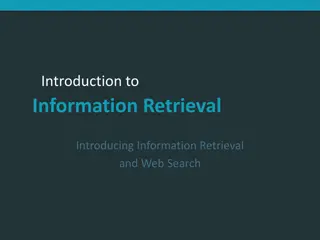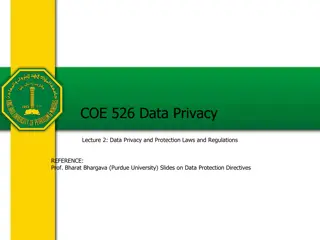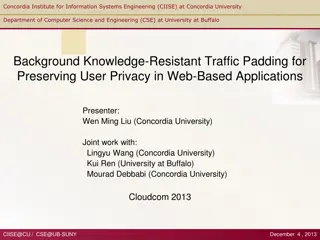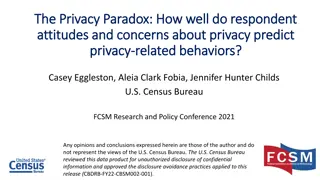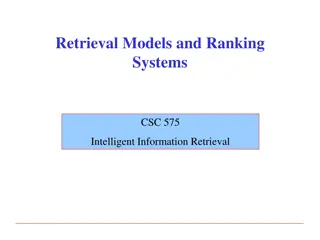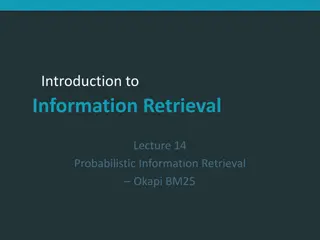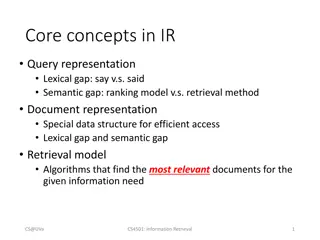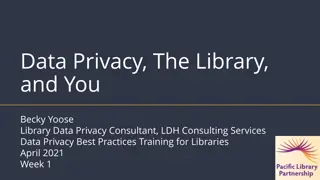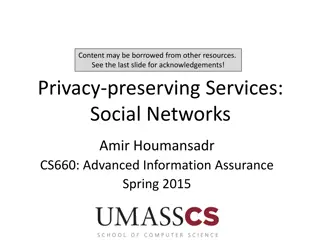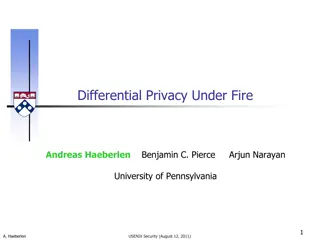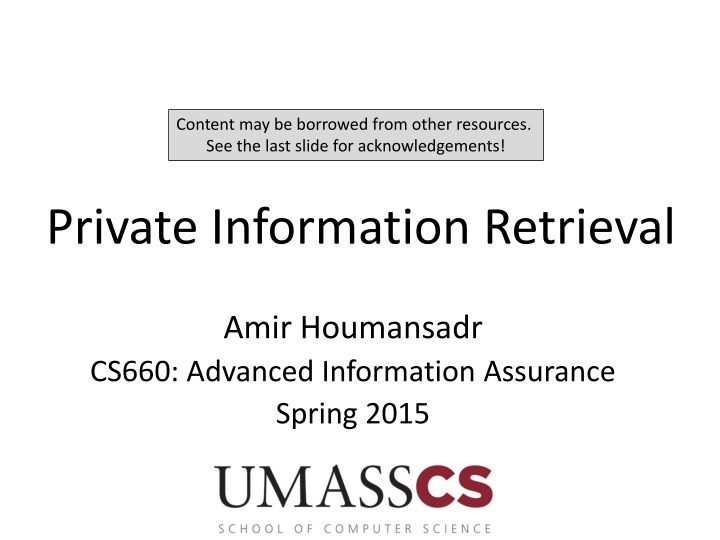
Private Information Retrieval: Protecting User Privacy in Databases
This content explores the concept of Private Information Retrieval (PIR) as a means to safeguard user privacy in databases. PIR allows users to retrieve data while concealing the identity of the specific items they are accessing. The goal of PIR is to enable querying databases without revealing the sought-after data items, thus ensuring privacy in various applications such as patient records, stock prices, and web access. Through cryptographic techniques, PIR helps users maintain confidentiality in interacting with databases, mitigating the risk posed by database owners having extensive knowledge about users.
Download Presentation

Please find below an Image/Link to download the presentation.
The content on the website is provided AS IS for your information and personal use only. It may not be sold, licensed, or shared on other websites without obtaining consent from the author. If you encounter any issues during the download, it is possible that the publisher has removed the file from their server.
You are allowed to download the files provided on this website for personal or commercial use, subject to the condition that they are used lawfully. All files are the property of their respective owners.
The content on the website is provided AS IS for your information and personal use only. It may not be sold, licensed, or shared on other websites without obtaining consent from the author.
E N D
Presentation Transcript
Content may be borrowed from other resources. See the last slide for acknowledgements! Private Information Retrieval Amir Houmansadr CS660: Advanced Information Assurance Spring 2015
AOL search data scandal (2006) #4417749: clothes for age 60 60 single men best retirement city jarrett arnold jack t. arnold jaylene and jarrett arnold gwinnett county yellow pages rescue of older dogs movies for dogs sinus infection Thelma Arnold 62-year-old widow Lilburn, Georgia
Observation The owners of the database know a lot about the users! This poses a risk to users privacy. E.g. consider database with stock prices Really? Can we do something about it? Yes, we can: or use cryptography! trust them that they will protect our secrecy,
How can crypto help? database D user U Note: this problem has nothing to do with side-channels, website fingerprinting, etc.
Threat Model secure link database D user U A new primitive: Private Information Retrieval (PIR)
Private Information Retrieval (PIR) [CGKS95] Goal: allow user to query database while hiding the identity of the data-items she is after. Note: hides identity of data-items; not existence of interaction with the user. Motivation: patient databases; stock quotes; web access; many more.... Paradox(?) :imagine buying in a store without the seller knowing what you buy. (Encrypting requests is useful against third parties; not against owner of data.)
Model Server: holds n-bit string x n should be thought of as very large User: wishes to retrieve xi and to keep i private
Private Information Retrieval (PIR) i j i{1, n} xi x=x1,x2 , . . ., xn {0,1}n USER SERVER
Non-Private Protocol xi i{1, n} i x =x1,x2 , . . ., xn SERVER USER NO privacy!!! Communication: 1
Trivial Private Protocol x1,x2 , . . ., xn x =x1,x2 , . . ., xn xi SERVER USER Server sends entire database x to User. Information theoretic privacy. Communication: n Not optimal !
Other solutions? User asks for additional random indices. Drawback :leaks information, reduces communication efficiency Employ general crypto protocols to compute xi privately. Drawback: highly inefficient (polynomial in n). Anonymity (e.g., via Anonymizers). Note: different concern: hides identity of user; not the fact that xi is retrieved.
Two Approaches for PIR Information-Theoretic PIR[CGKS95,Amb97,...] Replicate database among k servers. User queries all the servers Computational PIR[CG97,KO97,CMS99,...] Computational privacy,based oncryptographic assumptions.
Known Comm. Upper Bounds Multiple servers, information-theoretic PIR: 2 servers, comm. n1/3[CGKS95] k servers, comm. n1/ (k)[CGKS95, Amb96, ,BIKR02] log n servers, comm. Poly( log(n) ) [BF90, CGKS95] Single server, computational PIR: Comm. Poly( log(n) ) Under appropriate computational assumptions [KO97,CMS99] Sub-linear with n
ApproachI: k-Server PIR x {0,1}n S1 i x{0,1}n S2 U Correctness: User obtains xi Privacy: No single server gets information about i x{0,1}n Sk
A 2-server Information Theoretical PIR n 0 1 0 0 1 1 0 1 0 0 1 0 S1 S2 i i U
A 2-server Information Theoretical PIR n 0 1 0 0 1 1 0 1 0 0 1 0 S1 S2 i Q1 subset {1, ,n} i Q1 i U
Protocol I: 2-server PIR n 0 0 1 0 0 1 1 0 1 0 0 1 0 S1 S2 i = a x Q1 subset {1, ,n} i Q1 1 Q 1 i U
Protocol I: 2-server PIR n 0 0 1 0 0 1 1 0 1 0 0 1 0 S1 S2 i Q2=Q1 + {i} = a x Q1 subset {1, ,n} i Q1 1 Q 1 i U
Protocol I: 2-server PIR n 0 0 1 0 0 1 1 0 1 0 0 1 0 1 S1 S2 i Q2=Q1 + {i} = a x = a x Q1 subset {1, ,n} i Q1 2 Q 1 2 Q 1 i U Weakness: Servers should not collude!
Protocol I: 2-server PIR n 0 0 1 0 0 1 1 0 1 0 0 1 0 1 S1 S2 i Q2=Q1 + {i} = a x = a x Q1 subset {1, ,n} i Q1 2 Q 1 2 Q 1 xi=a1 a2 i U Weakness: Servers should not collude!
Computation PIR Only one server, no need to trust Based on cryptographic assumptions Downside: Server has to run over the whole database, otherwise leaks information High computation load on the server CS660 - Advanced Information Assurance - UMassAmherst 21
PIR-Tor: Scalable Anonymous Communication Using Private Information Retrieval Prateek Mittal University of Illinois Urbana-Champaign Joint work with: Femi Olumofin (U Waterloo) Carmela Troncoso (KU Leuven) Nikita Borisov (U Illinois) Ian Goldberg (U Waterloo) Original slides from the authors USENIX Security 2011 22
Tor Background Directory Servers Trusted Directory Authority List of servers? Middle Signed Server list (relay descriptors) Exit Guards 1. Load balancing 2. Exit policy 23
Performance Problem in Tors Architecture: Global View Global view Not scalable Directory Servers List of servers? Need solutions without global system view 24 Torsk CCS09
Current Solution: Peer-to-peer Paradigm Morphmix [WPES 04] Broken [PETS 06] Salsa [CCS 06] Broken [CCS 08, WPES 09] NISAN [CCS 09] Broken [CCS 10] Torsk [CCS 09] Broken [CCS 10] ShadowWalker [CCS 09] Broken and fixed(??) [WPES 10] Very hard to argue security of a distributed, dynamic and complex P2P system. 25
Key Observation Need only 18 random middle/exit relays in 3 hours So don t download all 2000! Na ve approach: download a few random relays from directory servers Problem: malicious servers Route fingerprinting attacks Relay # 10, 25 Directory Server Download selected relay descriptors without letting directory servers know the information we asked for. Private Information Retrieval (PIR) 25: IP address, key 10: IP address, key Bob 10 25 Inference: User likely to be Bob 27
Private Information Retrieval (PIR) Information theoretic PIR Multi-server protocol Threshold number of servers don t collude A B Computational PIR Single server protocol Computational assumption on server Database C A Only ITPIR-Tor in this talk See paper for CPIR-Tor RA Database 28
ITPIR-Tor: Database Locations Tor places significant trust in guard relays 3 compromised guard relays suffice to undermine user anonymity in Tor. Choose client s guard relays to be directory servers At least one guard relay is honest All guard relays compromised Equivalent security to the current Tor network Exit relay compromised: Exit relay honest Middle Middle Exit Exit Middle Middle Exit Exit End-to-end Timing Analysis Deny Service ITPIR guarantees user privacy ITPIR does not provide privacy But in this case, Tor anonymity broken Guards Guards Guards Guards 29
ITPIR-Tor Database Organization and Formatting Middles, exits Separate databases Exit policies Standardized exit policies Relays grouped by exit policies Load balancing Relays sorted by bandwidth Sort by Bandwidth Relay Descriptors m1 e1 m2 e2 Exit Policy 1 m3 e3 m4 m5 m6 m7 m8 e4 e5 e6 e7 e8 Exit Policy 2 Non- standard Exit policies Middles Exits 30
ITPIR-Tor Architecture Guard relays/ PIR Directory servers Trusted Directory Authority 2. Initial connect 1. Download PIR database 3. Signed meta-information 5. 18 PIR Queries(1 middle/exit) 5. 18 middle,18 PIR Query(exit) 6. PIR Response m1 e1 m2 e2 4. Load balanced index selection m3 e3 m4 m5 m6 m7 m8 e4 e5 e6 e7 e8 Middles Exits 31
Performance Evaluation Percy [Goldberg, Oakland 2007] Multi-server ITPIR scheme 2.5 GHz, Ubuntu Descriptor size 2100 bytes Max size in the current database Exit database size Half of middle database Methodology: Vary number of relays Total communication Server computation 32
Performance Evaluation: Communication Overhead Advantage of PIR-Tor becomes larger due to its sublinear scaling: 100x--1000x improvement 1.1 MB 216 KB 12 KB Current Tor network: 5x--100x improvement 33
Performance Evaluation: Server Computational Overhead 100,000 relays: about 10 seconds (does not impact user latency) Current Tor network: less than 0.5 sec 34
Performance Evaluation: Scaling Scenarios Tor Communication (per client) ITPIR Communication (per client) ITPIR Core Utilization Scenario Explanation Relay Clients Current Tor 2,000 250,000 1.1 MB 0.2 MB 0.425 % 10x relay/client 20,000 2.5M 11 MB 0.5 MB 4.25 % Clients turn relays 250,000 250,000 137 MB 1.7 MB 0.425 % 35
Conclusion PIR can be used to replace descriptor download in Tor. Improves scalability 10x current network size: very feasible 100x current network size : plausible Easy to understand security properties Side conclusion: Yes, PIR can have practical uses! Questions? 36
Acknowledgement Some of the slides, content, or pictures are borrowed from the following resources, and some pictures are obtained through Google search without being referenced below: Stefan Dziembowski, Private Information Retrieval Amos Beimel, Private Information Retrieval Prateek Mittal, PIR-Tor CS660 - Advanced Information Assurance - UMassAmherst 37





